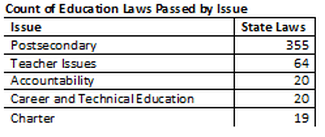Using data from Congress and the National Conference of State Legislatures, I found that state legislators have enacted more than 600 bills this legislative session. To better understand these changes, I also calculated the sum of education laws by NCSL education policy topics, which you can see below. (It’s important to note that not all laws create equal levels of change. For example, it’s possible for one law to change the name of a gymnasium and another to create a new teacher evaluation system.) This approach allows for a view into nationwide trends among states, but it doesn’t explain whether these were small or large changes in 2014.

If we follow Manna’s theory, we might believe that — based on this year’s state activity — Congress will also make changes to higher education policy. And that just might be true. The House Education and the Workforce Committee on has passed a package of three higher education bills that look to have bipartisan support for the reauthorization of the Higher Education Act. But there is limited time: Congressional work will slow down after Labor Day, as midterm elections gear up. From August to Election Day, Congress will be in session for a total of only three weeks.
As such, it’s more likely that states will serve as the locus of policymaking for the foreseeable future. Programs like Race to the Top and the No Child Left Behind waivers have put pressure on states to pass changes to state education policies. States will experiment with education policies tailored to local political needs. This creates tremendous downward pressure on states to make education policy changes. If more reforms are to come in 2014, don’t count on Congress; these changes are likely to be around education issues that match the agendas of legislators and governors in states around the country.
Josh Bleiberg is a research analyst in the Center for Technology Innovation at the Brookings Institution. Reach him via email or Twitter.

 RSS Feed
RSS Feed